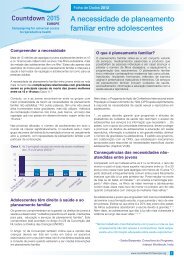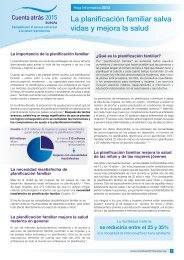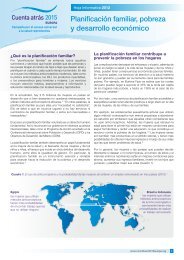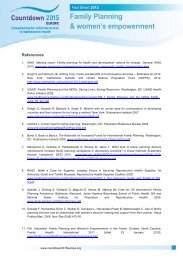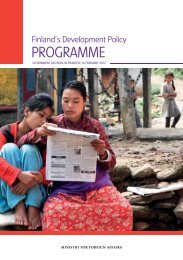Videos••Marie Stopes International (MSI) Make Women MatterCampaign short videos: http://www.makewomenmatter.org/watch••New York Times short video (4 minutes) about unmet needin Haiti (2009): http://video.nytimes.com/video/2009/04/04/opinion/1194839118170/saving-lives-with-family-planning.html••Population Reference Bureau (PRB) video (16 minutes)highlights how family planning contributes to economicgrowth and poverty reduction at the family, community andnational levels, and aims to reposition family planning higheron policy agendas in sub-Saharan Africa: http://www.prb.org/Journalists/Webcasts/2011/family-planning-povertyreduction.aspx(PRB website suggests a French version willbe available soon.)PhotobanksPlanetwire: provides free images of development-related topics,including women’s and children’s health and HIV, to NGOs andothers: http://www.planetwire.org/audiovisuals.phpPhotoshare: thousands of international health and developmentimages, free <strong>for</strong> non-profit and educational usehttp://www.photoshare.org/World Bank photos: Images are available <strong>for</strong> free at high (8”x12”300dpi) and low resolutions.<strong>The</strong>se are not suitable <strong>for</strong> printing. Low-resolution images canbe found on the World Bank Flickr site: www.worldbank.org/flickrFor PC users, right-click on the image and choose a size fromthe menu that pops up. This will take you to a page where youcan download the photo.For printed documents, use high-resolution images (8”x12”,300dpi). <strong>The</strong>se can be found at the World Bank photolibrary: http://secure.worldbank.org/photolibrary/servlet/main?pagePK=149932For PowerPoint presentations and online documents orwebsites, you can use low-resolution images (8”x12” 72dpi).GlossaryContraceptive prevalence rate<strong>The</strong> proportion of women of reproductive age who are using (orwhose partner is using) a contraceptive method at a given pointin time.<strong>Family</strong> planningMethods and strategies which enable individuals and couplesto anticipate and attain their desired number of children and thespacing and timing of their births. It is achieved through use ofcontraceptive methods and the treatment of involuntary infertility.A woman’s ability to space and limit her pregnancies has a directimpact on her health and well-being as well as on the outcomeof each pregnancy.Fertility rateMeasures which relate the number of births in a given period tothe number of women of reproductive age (unlike the crude birthrate, which relates births to the whole population). <strong>The</strong> generalfertility rate relates births in a particular period, usually a year, towomen aged 15–49 or 15–44 years at that time. Age-specificfertility rates relate births to women in specific reproductive agegroups, e.g. 15–19, 20–24. <strong>The</strong>se rates are usually expressedper 1000 women. <strong>The</strong> total fertility rate sums the age-specificrates to provide a hypothetical average number of childreneach woman would have if the current rates prevailed over herchildbearing period.Modern contraceptivesClinic and supply methods of contraception, including femaleand male sterilization; Intra Uterine Devices; hormonal methods,such as oral pills, injectables, hormone-releasing implants, skinpatches, and vaginal rings; male and female condoms; andvaginal barrier methods, such as the diaphragm, cervical cap,spermicidal foams, jellies, creams and sponges.Total fertility rateAverage number of children born alive to a woman during herlifetime. More specifically, TFR is the expected number of childrena women who survives to the end of the reproductive age spanwill have during her lifetime if she experiences the given agespecificrates. TFR shows the potential <strong>for</strong> population change ina country. A rate of two children per woman is considered thereplacement rate <strong>for</strong> a population, resulting in relative stability interms of total numbers.Traditional methods of family planningNon-pharmaceutical or non-barrier methods of pregnancyprevention, including rhythm, withdrawal, abstinence andlactational amenorrhoea (a method based on the naturalpostpartum infertility that occurs when a woman is fullybreastfeeding and not menstruating; women must becontinuously and exclusively breastfeeding and less than sixmonths postpartum). Studies show the ineffectiveness of usingsuch methods.Unintended pregnancyA pregnancy that occurs when a woman wants to postponeconception <strong>for</strong> at least two years or did not want to becomepregnant at all.38 www.countdown<strong>2015</strong>europe.org
ReferencesAsh<strong>for</strong>d, L. (2003) <strong>Unmet</strong> need <strong>for</strong> family planning. Policy Brief. Washington, DC:Population Reference Bureau.Barot, S. (2008) Back to Basics: <strong>The</strong> Rationale <strong>for</strong> Increased Funds <strong>for</strong> International<strong>Family</strong> <strong>Planning</strong>. Policy Review. Washington, DC; Guttmacher Institute.Birdsall, N., A. Ibrahim, et al. (2004) Task Force 3 Interim Report on Gender Equality.Millennium Project background paper. New York: United Nations.Bloom D, Williamson J. Demographic Transitions and Economic Miracles in EmergingAsia. World Bank Economic Review. 1998.12:419–55. http://www.nber.org/papers/w6268.pdf?new_window=1.Bryant, L., L. Carver, et al. (2009) Climate change and family planning: least-developedcountries define the agenda. Bulletin of the World Health Organization 87: 852–857.Center <strong>for</strong> Global Development Case 13: Reducing Fertility in Bangladesh. Case Study.Washington, DC: Center <strong>for</strong> Global Development.Center <strong>for</strong> Reproductive-Rights/UNFPA (2010) <strong>The</strong> Right to Contraceptive In<strong>for</strong>mationand Services <strong>for</strong> Women and Adolescents. Briefing Paper. New York: Center <strong>for</strong>Reproductive Rights and UNFPA.<strong>Europe</strong>an Commission (2007) Reproductive Health Commodity Security Study: Keyfindings and recommendations <strong>for</strong> the <strong>Europe</strong>an Commission. Final report. Brussels:<strong>Europe</strong>an Commission.FHI. Women’s Voices, Women’s Lives: <strong>The</strong> Impact Of <strong>Family</strong> <strong>Planning</strong> – A Synthesisof Findings from the Women’s Studies Project. North Carolina, USA: <strong>Family</strong> HealthInternational.Grown, C., G. Gupta, et al. (2003) Background Paper of the Task Force on Educationand Gender Equality, Promises to Keep: Achieving Gender Equality and theEmpowerment of Women. Millennium background paper. New York: United Nations:5 and 11.Guttmacher (2010) Facts on Investing in <strong>Family</strong> <strong>Planning</strong> and Maternal and NewbornHealth. In Brief. Washington, DC: Guttmacher Institute.Guttmacher/Ethiopian Society of Obstetricians and Gynecologists (2010) Benefits ofMeeting the Contraceptive <strong>Need</strong>s of Ethiopian Women. In Brief. Washington, DC:Guttmacher Institute/UNFPA.Guttmacher/IPPF (2010) Facts on Satisfying the <strong>Need</strong> <strong>for</strong> Contraception In DevelopingCountries. In Brief. Washington, DC: Guttmacher Institute and IPPF.IPPF (2006) Death and Denial: Unsafe Abortion and Poverty. London: IPPF.IPPF (2008) Contraception at a crossroads. London: IPPF.Lancet/UCL (2009) Managing the health effects of climate change. Lancet 373: 1693–1733.Lule, E., S. Singh, et al. (2007) Fertility Regulation Behaviors and <strong>The</strong>ir Costs:Contraception and Unintended Pregnancies in Africa and Eastern <strong>Europe</strong> & CentralAsia. Health, Nutrition and Population (HNP) Discussion Paper. Washington, DC:World Bank Human Development Program.Mackenzie, H., A. Drahota, et al. (2010) What kind of family planning deliverymechanisms increase family planning acceptance in developing countries? A mixedmethods Systematic Review. Hampshire: DFID.OECD Development Centre. (2007) Gender Equality And Social Institutions In KyrgyzRepublic. Social Institutions & Gender Index (SIGI). Retrieved 20 October 2011 fromhttp://genderindex.org/sites/default/files/pdfs/KGZ.pdf.PPAG (2009) <strong>The</strong> Case <strong>for</strong> Adding <strong>Family</strong> <strong>Planning</strong> on the National Health InsuranceScheme (NHIS). Position Paper. Accra: Planned Parenthood Association of Ghana.RHSC. Fact Sheet: HAND to HAND Campaign Core Messaging. Brussels:Reproductive Health Supplies Coalition.RHSC. Understanding 100 million. Brussels: Reproductive Health Supplies Coalition.Retrieved 18 October 2011 from http://www.rhsupplies.org/understanding-100-million.html.RHSC (2009) Make a Case <strong>for</strong> Supplies, Leading Voices in Securing ReproductiveHealth Supplies: An Advocacy Guide and Toolkit. Brussels: Reproductive HealthSupplies Coalition.Ross, J. and J. Stover (2009) Contraceptive Projections and the Donor Gap, Meetingthe Challenge. Brussels: Reproductive Health Supplies Coalition.Rutstein S.O. (2008) Further evidence of the effects of preceding births intervals onneonatal, infant and under-five years mortality and nutritional status in developingcountries: evidence from the demographic and health surveys. DHS Working Paper.Calverton, MD, USA: MacroInternational. 41.Sedgh, G., R. Hussain, et al. (2007) Women with an unmet need <strong>for</strong> contraception indeveloping countries and their reasons <strong>for</strong> not using a method. Occasional Report.New York: Guttmacher Institute. 37.Singh, S., J. Darroch, et al. (2009) Adding it up: <strong>The</strong> costs and benefits of investingin family planning and maternal and newborn health. New York: Guttmacher Instituteand United Nations Population Fund (UNFPA).Singh S. , J. Darroch, et al. (2012) Adding It Up: Costs and Benefits of ContraceptiveServices – Estimates <strong>for</strong> 2012. New York: Guttmacher Institute and United NationsPopulation Fund (UNFPA).Singh, S., D. Wulf, et al. (2009) Abortion worldwide: a decade of uneven progress.New York: Guttmacher Institute.Speidel, J., S. Sinding, et al. (2009) Making the Case <strong>for</strong> US International <strong>Family</strong><strong>Planning</strong> Assistance. Baltimore, MD: Johns Hopkins Bloomberg School of PublicHealth, Bill and Melinda Gates Institute <strong>for</strong> Population and Reproductive Health.UK APPG on Population, Development and Reproductive Health (2009) Better OffDead? A report on maternal morbidity from the UK All Party Parliamentary Groupon Population, Development and Reproductive Health. London: UK All PartyParliamentary Group on Population, Development and Reproductive Health.UN-DESA (2011) <strong>The</strong> Millennium Development Goals Report 2010. New York:United Nations.UN Secretary General (2010) Global Strategy <strong>for</strong> Women’s and Children’s Health.Geneva: United Nations.UN Women. <strong>The</strong> health sector is a key entry point <strong>for</strong> survivors. Virtual KnowldegeCentre to End Violence Against Women and Girls. http://www.endvawnow.org/en/articles/428-the-health-sector-is-a-key-entry-point-<strong>for</strong>-survivors.html.UN (2009) World population prospects: the 2008 revision, Highlights. Working Paper.New York: United Nations.UN (2011) <strong>The</strong> Millennium Development Goals Report 2011. New York: UnitedNations.UN (2011) World Contraceptive Use 2010. New York: United Nations.UNDP (2010) Gender, Climate Change and Community-Based Adaptation. NewYork: UNDP.UNFPA (2002) State of the World Population 2002. New York: UNFPA.UNFPA (2005) State of the World Population 2005. New York: UNFPA.USAID. <strong>Family</strong> planning enlists imams in Egypt. Success Story. Washington, DC: USAID.USAID Indonesia. Birth spacing empowers Indonesians. Success Story. Washington,DC: USAID.USAID (2009) Achieving the MDGs: <strong>The</strong> contribution of family planning, Yemen. HealthPolicy Initiative, Task Order 1. Washington, DC: USAID.USAID (2009) <strong>Family</strong> <strong>Planning</strong> and the MDGs: Saving Lives, Saving Resources. TaskOrder. Washington, DC: USAID Health Policy Initiative.USAID/DELIVER (2006) Guaranteeing Widespread Access to a Broad Choice ofContraceptives – Paraguay. State of the Practice Brief. Arlington, VA: USAID andDELIVER.USAID/WHO Regional Office <strong>for</strong> Africa (2008) Repositioning family planning: Guidelines<strong>for</strong> advocacy action. Washington, DC: World Health Organization, Regional Office <strong>for</strong>Africa, and the United States Agency <strong>for</strong> International Development (USAID). http://www.who.int/reproductivehealth/publications/family_planning/fp_advocacytool_kit.pdf.Vlassoff, M., A. Sundaram, et al. (2009) Benefits of meeting the contraceptive needs ofUgandan women. In Brief. New York: Guttmacher Institute: 4.WHO (2009) Achieving Millennium Development Goal 5. Briefing Note. Geneva: WHO.WHO (2009) Strategic Considerations <strong>for</strong> Strengthening the Linkages between<strong>Family</strong> <strong>Planning</strong> and HIV/AIDS Policies, Programs and Services. Geneva: WHO.WHO (2010) Meeting report: <strong>Family</strong> planning <strong>for</strong> health and development: actions<strong>for</strong> change. Geneva: WHO.WHO (2010) Trends in Maternal Mortality 1990–2008. Geneva: WHO.WHO (2011) Unsafe Abortion: Global and regional estimates of the incidence ofunsafe abortion and associated mortality in 2008, 6th Edition. Geneva: WHO.www.countdown<strong>2015</strong>europe.org39








